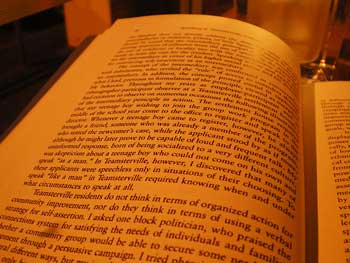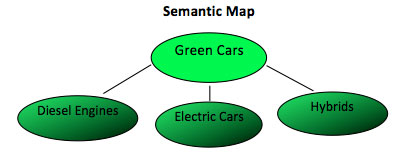Understanding the Text’s Organization

Source: I read run on sentences., jenWaller,Flickr
Just by looking through the article, you have already learned quite a bit about the content. You probably predicted that the article will discuss energy costs, wind power, and solar energy. You probably also guessed that the writer wrote the article to inform us about the efficiency that energy co-ops can offer. Just by looking at headings, graphics, and images, you gained some understanding about the material.
Now let’s carefully scan the article thinking about how the writer organized her writing. Understanding how a writer organizes an essay can help you understand the essay better. Good writers are able to organize their writings so that ideas flow seamlessly from one to another, leading the reader through the essay. To visualize the organization and to see how ideas connect in this article, you are going to develop a semantic map. In this article, all of the writer's new ideas are introduced in bold blue font. As you read, you may see that some of these ideas seem more important than others, but there is no way to know which are more important without reading and thinking about the writer's intent. You might see that some of the ideas can be grouped together. To see how this works, follow these directions for the activity that follows:
- Drag and drop the article’s title or subject in the center oval.
- Drag and drop the headings that you think are important ideas to fill in the surrounding ovals.
- Drag and drop the remaining headings that you think can be grouped with the ideas you selected in step 2.
Refer to the article as you work through the semantic map exercise. When you are finished, you should have a semantic map for one possible way to organize the essay.
Look at the prediction you wrote earlier. Does the article’s organization confirm your prediction? If not, revise it using your notes.
Mapping out a chapter to understand its organization gives you a good sense of what the author thinks is important. The headings show you what the main sections cover; subheadings show relationships under each heading, and the placement of sidebars often indicates connected content. Even if the sidebars are not next to the related content, you can often make connections just by reading the sidebar titles and relating them to what you already know about each section of the article.
If you really don’t know much about a topic, different levels of headings can indicate relationships in content. For example, if you see the heading “Green Cars” and then smaller headings such as “Diesel Engines,” “Hybrids,” and “Electric Cars” beneath it, you can guess that the smaller headings are categories of green cars. Here’s how to plot the heading and subheadings on an outline or a semantic map.

Outline
A. Green Cars
- Diesel Engines
- Hybrids
- Electric Cars